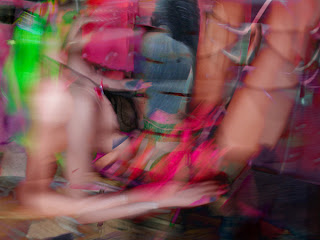I highly recommend visiting the Berlinische Galerie the next time you are in Berlin. There is an excellent collection of art there which was made in Berlin as well as many great contemporary artists on view. The museum had many artists working in site specific installation which is one of my personal favorites. We are so accustomed to entering an art institution and walking past rows upon rows of two-dimensional artworks that we often forget about the space which exists beyond the flat surface of the gallery walls. It is a wonderful decision when a curator chooses to engage viewers with the actual space of the gallery or museum, so that people can walk around, through or on top of artworks. This method of display helps to break us out of the redundant viewing experience one can have when wandering through room upon room of images hung on the walls. For some reason, installation engages me in a way that gives my viewing experience a little pep, and I have found that my energy level increases, making the rest of my trip through the museum a little less tiring.
 |
| Berlinische Galerie, Berlin |
On view was the exhibition "Art in Berlin 1880-1980", in which all of the artworks are part of the permanent collection of the Berlinische Galerie. The show was arranged chronologically and included artworks from multiple movements which I find fascinating in the history of art. They included, but were not limited to: Secessionists, Avant-Garde, November Group, Dada, New Objectivity, Postwar Surrealism, Abstraction, Postwar Architecture, and New Figuration.
 |
| Hannah Höch & Dadaist Propaganda |
 |
| George Grosz / John Heartfield "The Conformist Turned Wild", Electro-mechanical Tatlin Sculpture, 1920 |
 |
| John Heartfield and Rudolf Schlichter, "Prussian Archangel", 1920 I was surprised to see the installation of this piece, which I believe is a re-construction of the original, to be very close to its initial means of display at the First International Dada Fair in 1920. |
The rest of the exhibition was lengthy, and I spent an hour and a half navigating the multiple rooms.
The lower level of the museum contained works by contemporary artists, some of which I found quite stimulating. In the first room you enter after showing your ticket to the guard, there were five trees hanging from rotating axles which were suspended between the gallery walls. It is by far, one of my all time favorite installations by Michael Sailstorfer, the recipient of the Vattenfall Contemporary 2012 entitled Forst.


Watching Forst in motion, was akin to watching the waves hit the beach, or leaves caught in the wind because each time the trees rotated on their axis, the level of movement and sound was different. Below each tree, bits of branches and leaves formed concentric circles, and spirals as the trees deteriorated within the gallery walls. The effect was sensational and romantic within the confines of the white cube, and I derived as much pleasure from the installation as from watching other viewers interact with the work and observe it. I had a child-like grin plastered on my cheeks when I noticed the museum guard staring at one of the trees as if he was in a trance. I am so pleased with an installation when an artist shows us there is more to artwork and our experience outside of a gallery than flat two dimensional paintings or photographs. Works like Sailstorfer's Forst, help us to re-imagine what we believe should or should not be displayed in a museum. Is it art in the traditional sense-no, but did it put a smile on my face and inspire me? Yes, and because of that, I feel that something qualifies as art when it has an effect on my state of being; when an artwork sparks my interest or challenges my belief system I am suddenly engaged and I leave the gallery fulfilled.











